Very Short Answer Questions :
1 ) What are the values of angle of incidence and angle of reflection for normal incidence of light on a plane mirror ?
Answer : Angle of incidence = zero degree
Angle of reflection = zero degree
2 ) No matter how far you stand from a mirror, your image always appears erect and diminshed. what is the type of mirror ? zero
Answer : Convex mirror
3 ) Define centre of curvature of a mirror ?
Answer : The centre of a sphere of which the mirror is part is called as the centre of curvature.
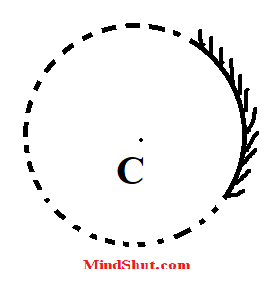
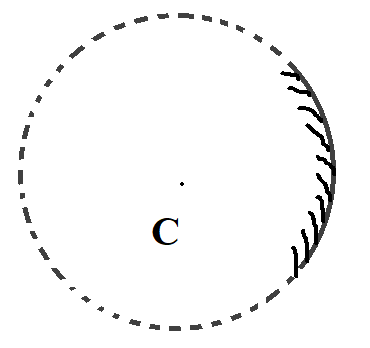
4 ) What is pole of a spheircal mirror ?
Answer : The point of intersection of Spherical mirror and the principal axis is called as the pole of the mirror.In the following figure, the point P is the pole of the mirror.
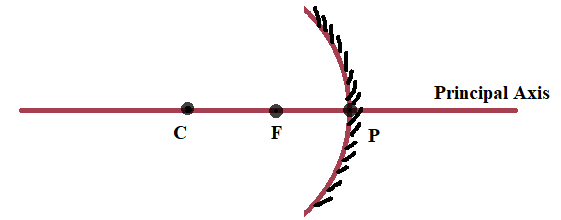
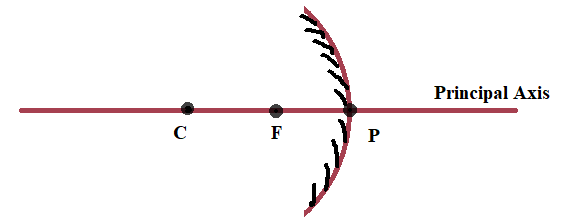
5 ) Write the relation between radius of curvature and focal length of a conave mirror ?
Answer : R = 2f
Where R is the radius of curvature and f is the focal length.
6 ) What kind mirror is needed for shaving ?
Answer : Concave mirror
7 ) What is refractive index of a medium ?
Answer : According to Snell’s law of refraction of light, the refractive index of a medium is nothing but the ratio of sine of angle of incidence to the angle of refraction. Actually it represents the density of a medium with respect to other medium.
8 ) What happens when a ray of light strikes the surface of separation between the two media at right angle ?
Answer : It is the case of normal incidence and therfore, there is no change in the direction of light rays.
9 ) What is the angle between the incident ray and the emergent ray of light, when incident ray of light falls obliquely on the galass slab ?
Answer : zero degree because the incident ray and emergent ray are parallel to each other with a lateral shift.
10 ) Define refractive index of a medim ?
Answer : According to Snell’s law of refraction of light, the refractive index of a medium is nothing but the ratio of sine of angle of incidence to the angle of refraction. Actually it represents the density of a medium with respect to other medium.
11 ) What is the focal length of a lens ?
Answer : The focal length of a lens is defined as the distance between the principal focus and optical centre of the lens.
12 ) What is a prism ?
Answer : Prism is a homogeneous transparent refracting medium bounded by at least two non-parallel surfaces inclined at some angle.
13 ) What is a lens ?
Answer : A lens is a transparent refracting medium bounded by two curve surfaces which are generally spherical
14 ) What is power of a lens ?
Answer : Power of a lens is defined as the inverse of its focal length.
15 ) What is the unit of power of a lens ?
Answer : Diptre is the unit of power of a lens.
16 ) What is a photo graphic camera ?
Answer : A photographic camera is a device that can produce permanent image of an object on a photgraphic plate or film. It has light-tight box with its inner walls blackened to prvent internal refletions of light.
17 )Name two defects of human eye.
Answer : Longsightedness and short sightedness are the two defects of human eye.
18 ) What are the distances of near point and far point of a normal eye ?
Answer : The distances of near point is 25 cm while far point of a normal eye is infinity.
19 ) State a difference between the images frormed by human eye and photographic camera.
Answer : Human eye can produce the image of an object temprorary on retina and the image lasts only 1/10th of second whereas a photographic camera produces a permanent image of an object on the film.
20 ) What is disperson of light ?
Answer : The phenomenon of splitting of a polychromatic light into its constituent colours when it passes through a prism or prism like substance, is called as the dispersion of light.
21 ) What is the range of visible light ?
Answer : The range of visible light is from 380 to 700 nanometers.
22 ) What is scattering of light ?
Answer : The process of absorption of light energy and then re-emission of it, is called the scattering of light.
23 ) What is the nature of the image formed at the retina of human eye ?
Answer : The nature of the image formed at the retina of human eye is real and inverted.
24 ) Name the part of human eye which acts as a screen to obtain the image of an object.
Answer : Retina is the part of human eye whcih acts a screen to obtain the image of an object.
25 ) Name a phenomenon occuring in nature due to disperision of light.
Answer : Rainbow is a phenomenon occuring in nature due to disperision of light.
26 ) Name the component of white light that deviates (i) the least and (ii) the most while passing through a glass prism.
Answer : i) Red (ii) Violet
27 ) What colour of light is used for danger signal ?
Answer : Red
Short Answer Type Questions : ( 2 Marks Each ) r
28) Draw ray diagram to show the formation of images when object is placed in front of a concave mirror.(i) between the pole and focus (ii) between centre of curvature and focus.
i)
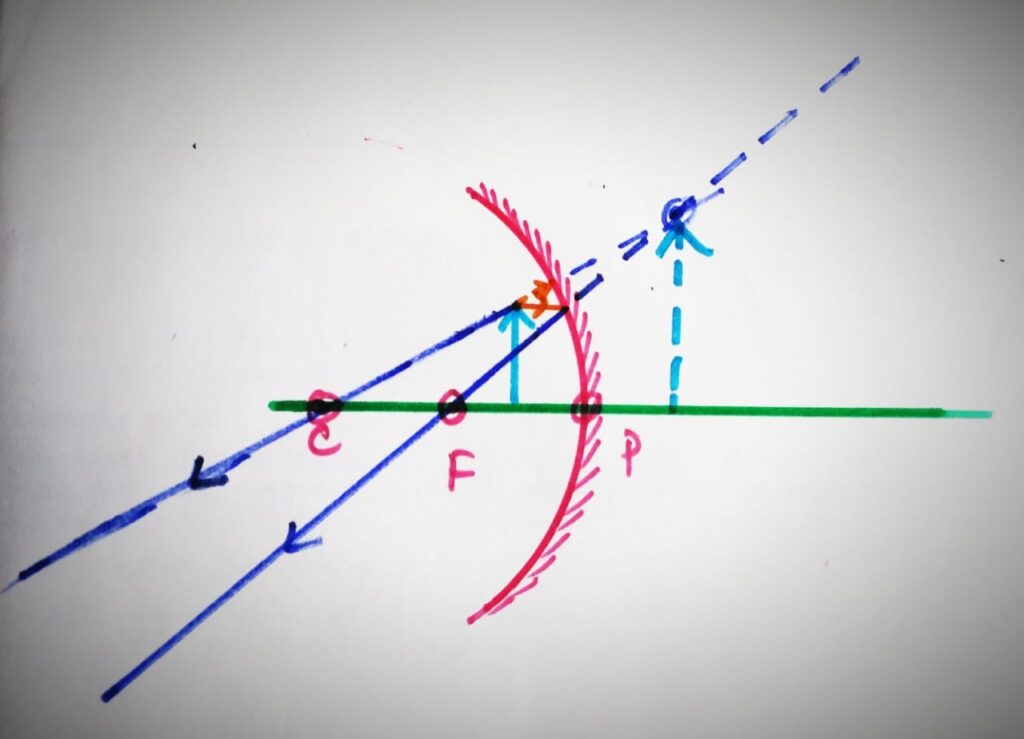
ii)
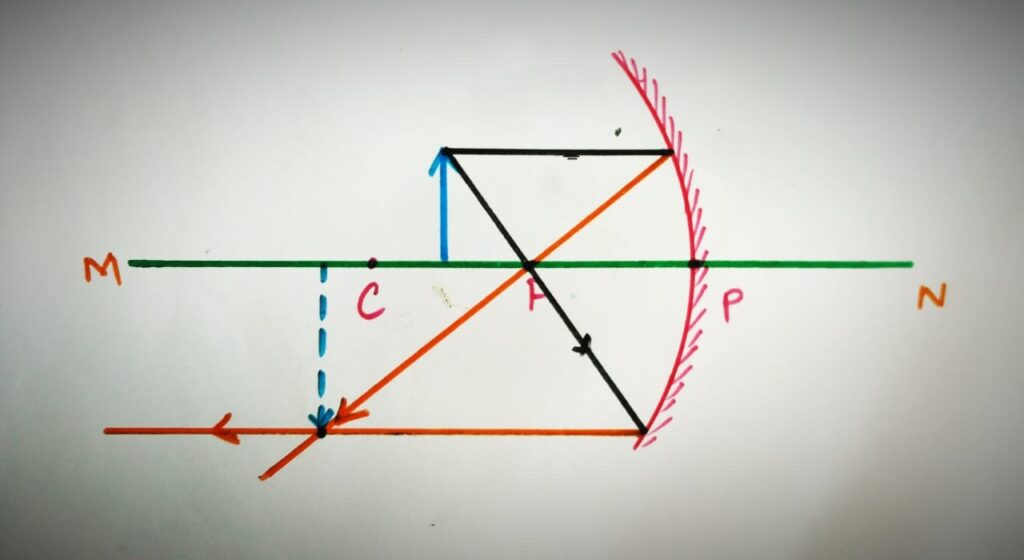
29 ) State three uses of a concave mirror ?
Answer : (i) It is used as the shaving mirror.
(ii) It is used as the dentist mirror.
(iii) It is used in the headlights of a vehicle.
30 ) State two uses of a convex mirror ?
Answer : (i)It is used as rearview mirror in vehicles.
(ii) It is used as a rflector in street lamps.
31) State laws of refraction of light.
Answer : Laws of Refraction :
1 ) The incident ray, point of incidence, normal and refracted ray of light are coplanar.
2 ) The ratio of sine of angle of incidence and angle of refraction is constant. ( This constant term is nothing but the refractive index of the medium )
i.e, sin i / sin r = constant
Where i = angle of incidence
r = angle of refraction
32 ) With the help of a diagram, show that when light falls obliquely on a side of a rectangular glass slab, the emergent ray is paralllel to the incident ray.
Answer :
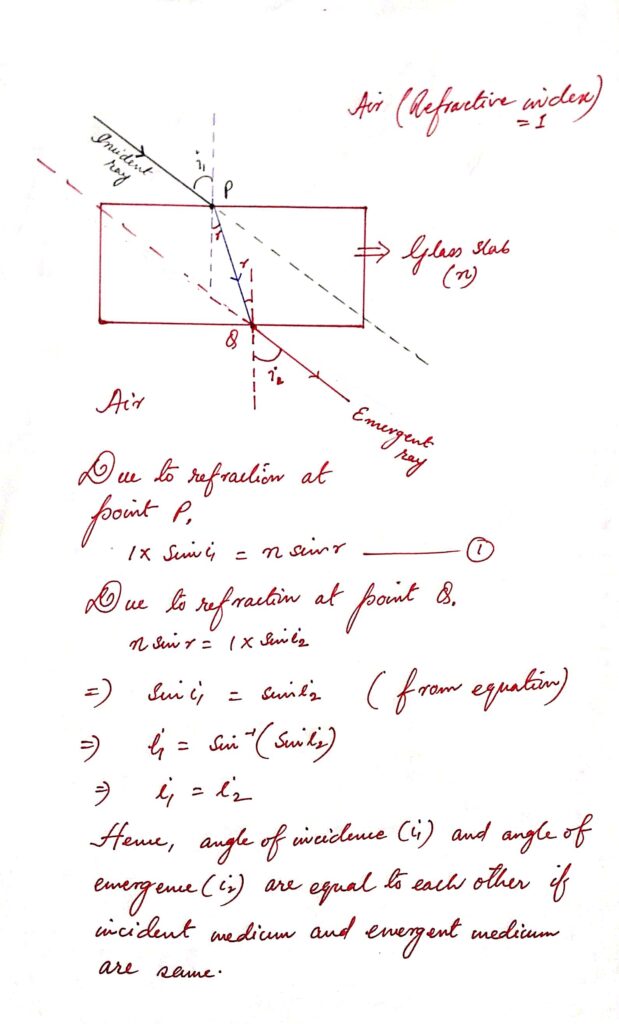
Therefore incident ray and emergent ray are parallel to each other with a lateral shift.
33 ) What is the diffecence between a convex lens and concave lens ?
Answer :
| Convex Lnes | Concave Lens |
|---|---|
| 1 ) It is thin at the edges. | 1 ) It is thick at the edges |
| 2 ) it is thick at the middle. | 2 ) It is thin at the middle. |
| 3 ) It can produce real as well as virtual image. | 3 ) It can produce only virtual and erect image. |
| 4 ) It can produce large or smaller or same or point size image with respect ot position of the object kept infront of the lens. | 4 )Whatever be the object size, it always produces image of smaller in size. |
| 5 ) It is used in photgraphic camera. | 5 ) It is used in peepholes. |
34 ) Refractive index of a medium with respect to air is always greater than 1. Why ?
Answer :
Let n = refractive index of a medium
v = speed of light in a particular medium
c = velocity of ligt in space or air or vaccum
n = c / v
and C > v
Therefore, c/v > 1.
Hence n > 1
Refractive index of a medium with respect to air is always greater than 1.
35) Mention two properties of image formed by a convex mirror.
Answer : (i) Image is erect and virtual.
(ii) Image is always diminished in size whatever be the object size.
36 ) What is dispersion of light ? What is its cause ?
Answer : Dispersion of Light : The phenomenon of splitting of a polychromatic light into its constituent colours when it passes through a prism or prism like substance, is called as the dispersion of light.
Cause of Dispersion : Each color of light has individual wavelength. Refractive Index depends on the wavelength of light rays. In other hand, angle of refraction depends on the refractive index. Hence each color of light refracts with different angle of refraction when a polychromatic light passes through a prism or prism like substance. Hence emerging rays have also different emergent agle. This why a polychromatic light disperses into its constituent colors when it passes through a prim or prism like substance.
37 ) Why does sky look blue?
Answer : The following points reflect why sky looks blue :
(i) The blue light has shorter wavelength than red light. Due to this, it is scattered most.
(ii) Violet light has shorter wavelength than blue but human eye is more sensitive towards blue color.
38 ) Why are the stop signals on roads coloured red ?
Answer : The stop signals on roads coloured red becuase of the following reason :
(i) Red colour has the longest wavelength.
(ii) It is least deviated.
(iii) It is least scattered by the molecules and other particles present in the atmospphere.
39 ) Describe the action of a camera.
40 ) Describe how can the focal length of a concave mirror be determined experimentally.
41 ) Describe some uses of spherical mirror.
42 ) Deduce the relation δ = i 1+ i2 – A
Answer :
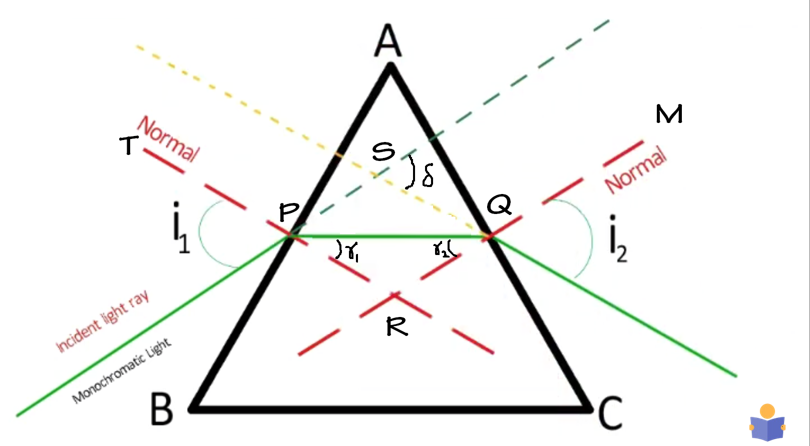
Let i1 = incident angle
i2 = emergent angle
? = angle of deviation
r1 = angle of refraction at the surface AB.
r2 = angle of incidence at the surface AC.
A = angle of prism = ∠ PAQ = ∠ BAC
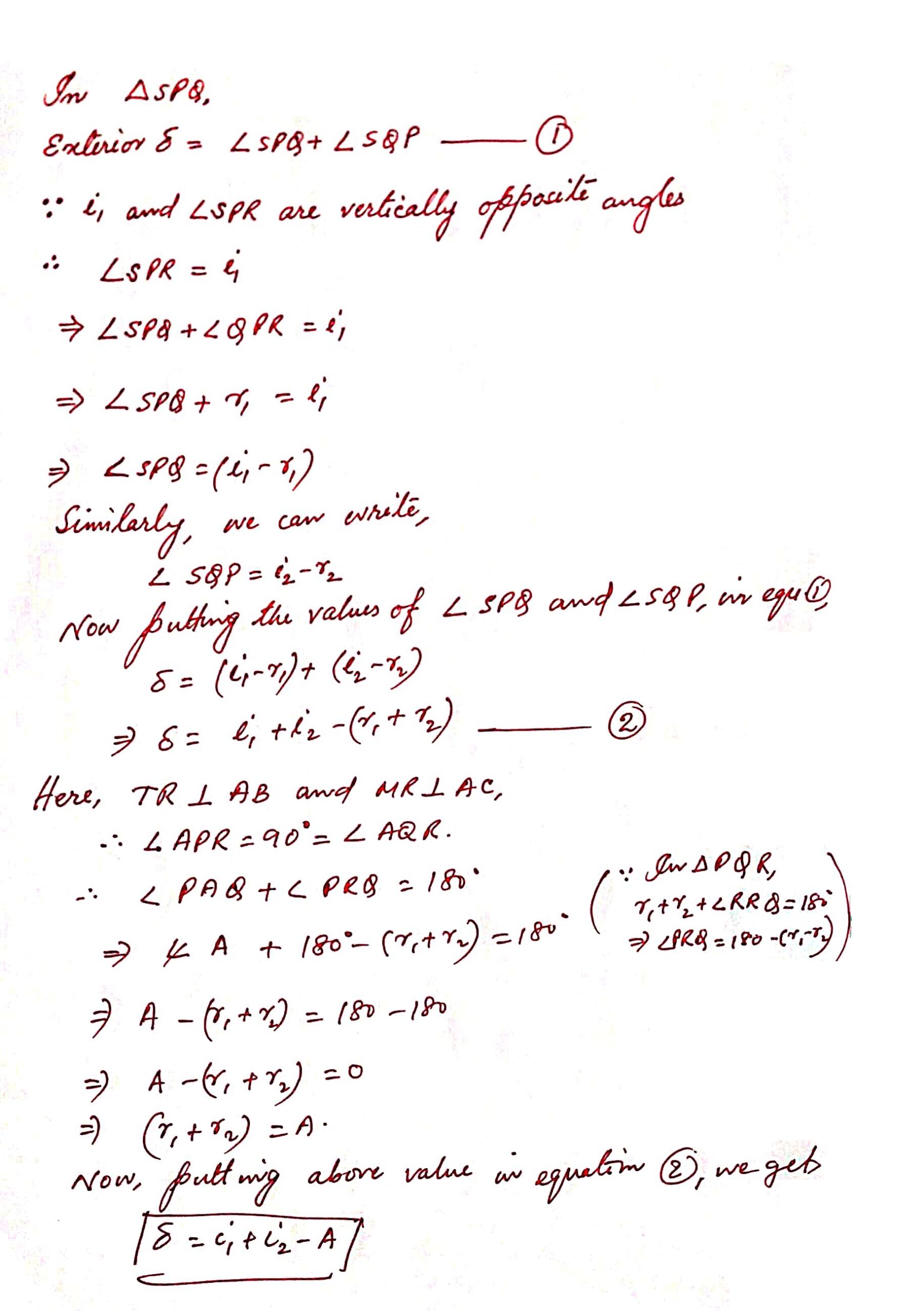
45 ) What is scattering of light ? Describe a natural phenomenon based on it.
Answer : The process of absorption of light energy and then re-emission of it, is called the scattering of light. Red colour of sky and sun at sun set and sun rise is a natural phenomenon based on scattering of light.
Objective Questions : ( 1 Mark Each )
I. Fill in the blanks :
(i) A convex mirror always produces a …….. image. ( Answer : virtual )
(ii) Refractive index of ammedium depneds uopn ….. of the light. ( Answer : wavelength )
(iii) A red flower appears ……in green light. ( Answer : black )
(iv) The sky appears blue due to …… of light. ( Anwer : scattering )
(v) In human eye the image is formed on…… ( Answer : retina )
II. State whether true or false :
(i) A convex mirror is used as driver’s mirror.( True)
(ii) The absolute refractive index of a medium can be less than unity. ( False )
(ii) A band of seven colours of white light is called spectrum.(True)
(iv) In a photograpphic camera a conave lens is used.( False )
(v) To correct long sightedness a concave lens of suitable focal length is used. ( False )
III.Match the following :
| Column I | Column II |
|---|---|
| 1 ) A Shaving mirror | 1 ) Concave lens |
| 2 ) Always virtual, erect, diminshed image | 2 ) red light |
| 3 ) Blue of the sky | 3 ) convex mirror |
| 4 ) Short sightedness | 4 ) concave mirror |
| 5 ) Danger signal. | 5 ) scattering of light |
Correct Answer :
| Column I | Column II |
|---|---|
| 1 ) A Shaving mirror | 4) concave mirror |
| 2 ) Always virtual, erect, diminshed image | 3) convex mirror |
| 3 ) Blue of the sky | 5 ) Blue of the sky |
| 4 ) Short sightedness | 1) concave lens |
| 5 ) Danger signal. | 2) red light |
IV. MCQ – Choose the correct answer :
(i) Which of the following materials can not used to make a lens ?
(a) water (b) glass (c) clay (d) Plastic
(ii) No matter how far you stand from a mirror, your image appears erect, the mirror is likely to be
(a) plane only (b) concave only (c) convex only (d) either plane or convex
(iii) A ray of light suffers refraction through an equiletral prism. the deviation produced by the prism does not depend on the
(a) angle of incidence (b) colour of light (c) size of the prism (d) material of the prism.
(iv) A ray of light incident on a lens parallel to its principal axis, after refraction passes through or appears to some from
(a) its second focus (b) its first focus (c) its optical centre (d) the centre of curvature of its second surface.
(v) the source of ultraviolet light is
(a) electric bulb (b) carbon arc lamp (c) red hot iron bulb (d) sodium
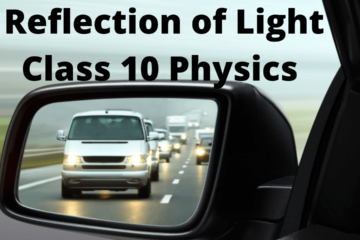
0 Comments